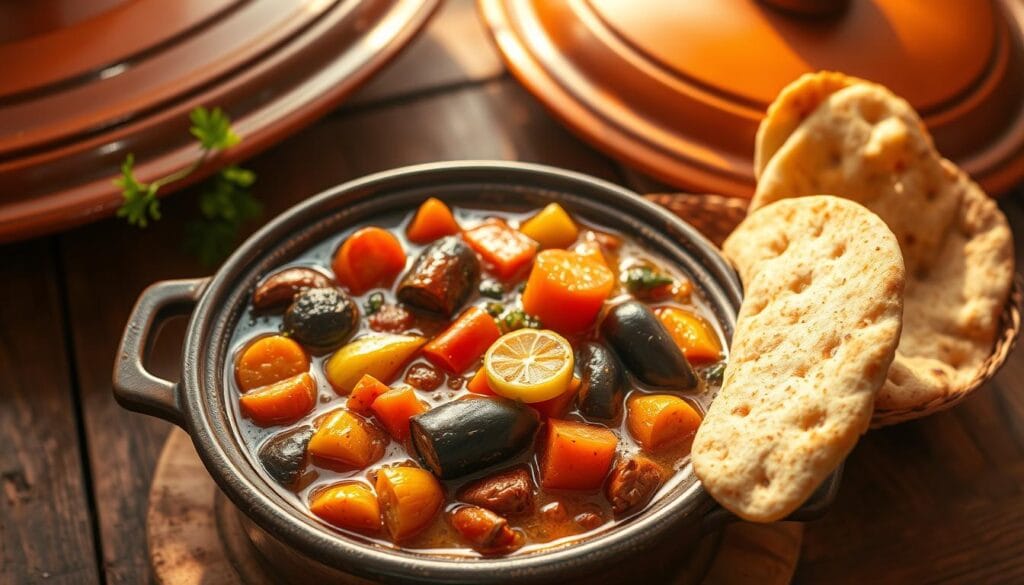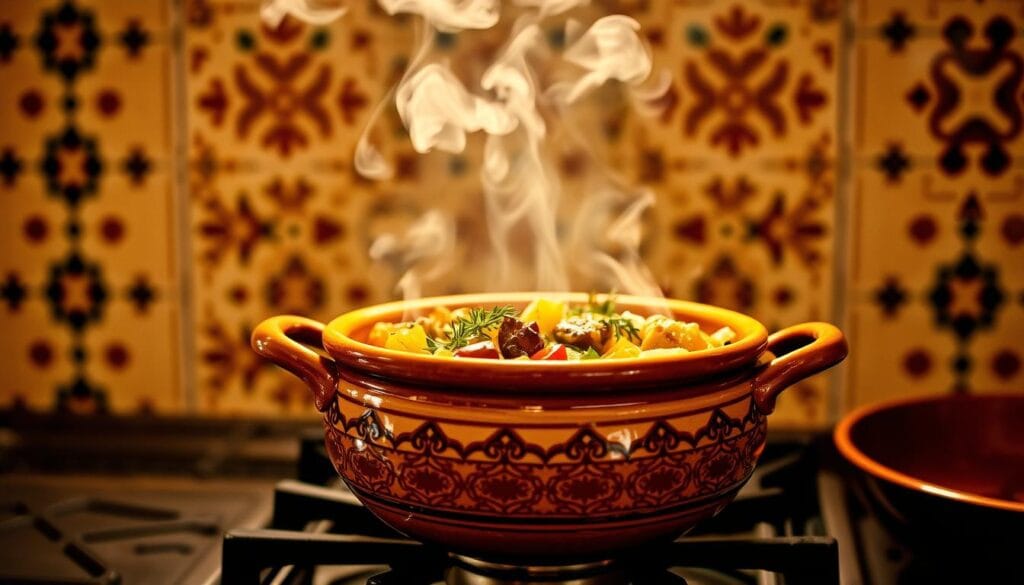Imagine stepping into a vibrant world where flavors dance on your palate, and every dish tells a story. Moroccan cuisine is more than just food—it’s an experience that connects you to centuries of tradition and cultural richness. Whether you’re gathering with family or hosting a casual dinner, these vegetarian recipes bring the authentic tastes of Morocco right to your home.
Traditional Moroccan cooking has evolved over time, yet its essence remains unchanged. Clay tagines, aromatic spices, and fresh, home-grown ingredients are at the heart of every dish. From the bustling street food markets to the warmth of family kitchens, the cuisine reflects a blend of influences from Andalusian Spain, Arabia, and France, creating a unique flavor profile that’s both familiar and exotic.
At the center of every Moroccan meal is the art of hospitality. A steaming pot of mint tea, sweetened with a touch of sugar, is more than a drink—it’s a symbol of welcome and togetherness. Pair it with a hearty breakfast dish like Shakshuka, or a fragrant lentil soup, and you’ve captured the essence of Moroccan hospitality in your own home.
What makes these recipes truly special is their innovative yet time-honored cooking methods. Whether you’re roasting vegetables at 425°F for 15 minutes to perfection or simmering a rich Harira soup for over an hour, every step is a celebration of tradition and taste. With a focus on fresh herbs like cilantro and thyme, and spices like cumin and ginger, these dishes are not just meals—they’re a journey through the senses.
In this article, you’ll discover how to create these authentic vegetarian recipes with ease. From the versatility of couscous to the comforting warmth of chickpea stews, we’ll explore the diverse and flavorful world of Moroccan vegetarian cooking. Get ready to embark on a culinary adventure that will leave your taste buds wanting more and your home filled with the aromatic scents of Morocco.
Table of Contents
Exploring the Rich Heritage of Moroccan Cuisine
Step into a world where every dish is a testament to centuries of cultural blending. Moroccan cuisine is a vibrant tapestry woven with threads from Andalusian Spain, Arabia, and France, creating a unique flavor profile that captivates the senses.
Cultural Influences and Traditional Flavors
The heart of Moroccan cooking lies in its historical evolution. Influenced by Persian, Arab, and Mediterranean techniques, traditional flavors were shaped by a rich exchange of spices and methods. Dishes like tagine and pastilla exemplify this blend, combining ingredients such as preserved lemon and olive paste to create bold, aromatic profiles.
Historical Evolution of Moroccan Food
Over the centuries, Moroccan cuisine has evolved, yet its essence remains intact. The balance of sweet and savory is a hallmark, seen in the use of cinnamon in both pastries and tagines. This balance extends throughout the day, from hearty breakfast soups like Harira to intricate main dishes served in the evening.
Heritage foods play a significant role, with dishes traditionally featuring chicken, lamb, and fish. While these meats are cultural markers, the focus here is on reinventing these classics in a vegetarian style, maintaining the authentic flavors without the meat.
In this section, we’ve explored the historical roots and cultural influences that define Moroccan cuisine, setting the stage for a culinary journey into its vegetarian delights.
Fresh and Flavorful Vegetarian Ingredients
At the heart of every delicious vegetarian dish lies the freshness and quality of its ingredients. Seasonal vegetables and legumes are the cornerstone of Moroccan vegetarian cooking, offering vibrant flavors and exceptional nutritional value.
Seasonal Vegetables and Legumes
- Seasonal vegetables like zucchini and carrots add bold flavors to Moroccan dishes.
- Onions and tomatoes create a robust base for broths and stews.
- Traditional methods involve simmering vegetables into hearty broths enjoyed even at breakfast.
- Slow-cooking transforms vegetables into tender, flavorful dishes.
- Selecting high-quality ingredients ensures authenticity in home cooking.
- These ingredients are versatile, forming the base for both simple and complex meals.
| Vegetable | Preparation | Nutritional Benefit |
|---|---|---|
| Carrots | Steamed or roasted | Rich in Vitamin A |
| Zucchini | Grilled or sautéed | High in antioxidants |
| Chickpeas | Boiled or stewed | Excellent protein source |
These ingredients not only enhance the taste but also provide a healthy foundation for every meal. Whether you’re preparing a quick salad or a slow-cooked tagine, the freshness of each component shines through, making every dish a delightful experience.
Moroccan Cuisine: Essential Spices and Flavor Profiles
Discover the vibrant world of spices that give Moroccan dishes their unique charm. At the heart of this culinary tradition lies a carefully balanced blend of aromatic spices, creating a flavor profile that captivates the senses.
Herbs and Spices That Define the Cuisine
Cumin and coriander are the backbone of Moroccan cooking, adding warmth and depth to every dish. These spices are used in measured amounts to create a harmonious balance. Ras hanout, a traditional mixture, brings complexity to the flavor, while hanout enhances the overall aroma.
Balancing Sweet, Savory, and Spicy Tones
Lemon juice and fresh herbs like parsley and cilantro add brightness, cutting through the richness of savory elements. A touch of pepper provides subtle heat, while ingredients like preserved lemon introduce tanginess. This careful layering transforms simple vegetables into extraordinary meals.
By replicating these spice blends at home, you can infuse your dishes with the authentic essence of Moroccan flavors, creating memorable vegetarian recipes that delight the palate.
Vegetarian Tagines and Slow-Cooked Delights
Discover the rich flavors of slow-cooked tagines, a cornerstone of traditional Moroccan cooking. These hearty stews are perfect for vegetarians, offering a medley of tender vegetables, aromatic spices, and grains that create a satisfying meal.
Creative Vegetable Tagine Variations
Vegetable tagines are a celebration of color and flavor. By slow-cooking a mix of carrots, zucchini, and chickpeas, the natural sweetness of the vegetables shines through. This method tenderizes even the toughest ingredients, creating a dish that’s both nourishing and delicious.
Complementary Couscous and Semolina Dishes
Couscous and semolina perfectly complement the bold flavors of tagines. These grains soak up the aromatic broth, adding lightness to each bite. Almonds and apricots bring a delightful crunch and sweetness, balancing the savory elements of the dish.
| Vegetable | Preparation | Nutritional Benefit |
|---|---|---|
| Carrots | Steamed or roasted | Rich in Vitamin A |
| Zucchini | Grilled or sautéed | High in antioxidants |
| Chickpeas | Boiled or stewed | Excellent protein source |

Experiment with ingredients to create unique tagine variations, blending tradition with modern tastes. This approach ensures every meal is both authentic and innovative, offering a culinary experience that delights the senses.
Invigorating Moroccan Salads and Light Meals
Moroccan salads are a symphony of flavors and textures, offering a refreshing contrast to richer dishes. These vibrant creations are designed to delight your senses and provide a light yet satisfying meal option.
Herb-Infused Salads with Zest
Imagine a salad that bursts with freshness, combining crisp greens, juicy vegetables, and tangy dressings. Moroccan salads are crafted to elevate your meal with vibrant herb dressings and freshly squeezed juice, creating a zesty counterpoint to heartier dishes.
Traditional Moroccan bread plays a central role in these meals. It’s not just a side—it’s a tool to scoop up every flavorful bite, transforming the salad into a satisfying experience. Some salads also incorporate couscous, adding a delightful texture and depth to each dish.
The interplay of flavors is subtle yet impactful. Mint and tea elements are integrated to create a refreshing taste, while the balance of sweet and savory notes ensures every bite is engaging. Whether you’re assembling a quick meal or a more elaborate spread, these salads are as visually appealing as they are healthy.
Moroccan Cooking Techniques Made Simple
Cooking Moroccan dishes might seem complex, but with the right techniques, it can be straightforward and enjoyable. At the heart of Moroccan cooking lies the clay pot and tagine, which allow flavors to meld beautifully over low heat. These traditional methods ensure that every dish is rich and aromatic, perfect for vegetarians and non-vegetarians alike.
Mastering Clay Pot and Tagine Methods
A clay tagine is more than just a cooking vessel; it’s a key to unlocking authentic Moroccan flavors. The conical lid allows steam to circulate, infusing the dish with moisture and flavor. To use a tagine, start by layering ingredients like onions, garlic, and spices at the bottom. Add your choice of vegetables or legumes, then pour in water or broth. Cover with the lid and let it simmer over low heat for about an hour, until the flavors have melded together and the ingredients are tender.
Infusion Techniques for Maximum Flavor
One of the secrets to a great tagine is the spice mixture. Ras hanout, a traditional blend, adds depth and complexity to the dish. You can make your own or use store-bought for convenience. Start by sautéing onions and garlic, then add the spices and let them infuse into the oil for a few minutes. This step enhances the aroma and flavor of the spices, creating a robust base for your dish.
| Component | Role | Benefit |
|---|---|---|
| Clay Tagine | Slow cooking vessel | Retains moisture and flavor |
| Ras Hanout | Spice blend | Adds depth and complexity |
| Water/Broth | Hydration source | Enhances flavor infusion |
Traditionally, tagines were used for dishes with chicken, meat, or fish. However, these methods are easily adapted for vegetarian cooking. Simply replace the protein with extra vegetables or legumes, and adjust the spices to taste. The result is a hearty, flavorful dish that’s perfect for any occasion.
For a delicious vegetarian tagine, try this vegetarian tagine recipe as a starting point. Experiment with different spices and ingredients to make it your own. With these simple techniques, you can create authentic Moroccan dishes in the comfort of your home.

Innovative Moroccan Vegan Recipe Ideas
Experience the fusion of tradition and modernity with these inventive vegan recipes that reimagine classic Moroccan dishes. Using plant-based ingredients, these creations offer fresh twists while preserving authentic flavors.
Grain Bowls and Creative Pastas
Grain bowls are a fantastic base for vibrant, healthy meals. Try mixing quinoa or couscous with roasted vegetables like zucchini and carrots, seasoned with cumin and coriander. Add some crunch with toasted almonds for texture. Creative pasta dishes can also be infused with Moroccan spices—toss spaghetti in a light almond butter sauce with sautéed onions and a hint of cinnamon for a unique flavor profile.
Refreshing Dips and Spiced Broths
Transform simple vegetables into extraordinary dishes with refreshing dips and spiced broths. A smoky eggplant dip seasoned with paprika and garlic can be served with crusty bread. For a comforting meal, simmer a spiced vegetable broth with ginger and turmeric, then serve with a side of steamed chickpeas. These dishes are both nourishing and flavorful, perfect for any occasion.
Don’t forget to pair your meals with a refreshing glass of mint tea. This traditional drink not only complements the spices in your dishes but also adds a cooling contrast to the warmth of the meal. With these innovative recipes, you can enjoy the essence of Moroccan flavors while embracing a vegan lifestyle.
Conclusion
As you conclude your journey through the vibrant world of vegetarian Moroccan recipes, remember that each dish is a gateway to a rich cultural tapestry. The blend of tradition and modern twists creates a culinary experience that’s both familiar and exciting.
At the heart of every memorable meal are carefully chosen ingredients and authentic spices. Cumin, coriander, and fresh herbs like mint and parsley add depth and warmth, transforming simple vegetables into extraordinary dishes. The traditional tagine method, with its slow-cooked layers of flavor, is a testament to the versatility of Moroccan cooking, adapting seamlessly to vegetarian and vegan preferences.
Experiment with fresh salads, hearty broths, and innovative grain bowls to bring a piece of this cultural richness into your home. Each meal is a celebration of global influences and time-honored traditions, inviting you to explore and create. Whether it’s a steaming pot of mint tea or a fragrant tagine, every bite is a reminder of the exciting flavors and genuine heritage that make this cuisine a true gift to the food world.

